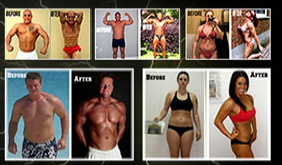Gaining muscle through exercise is a physically and psychologically rewarding journey that requires determination and a knowledge of the human body. While free workouts and workout plans abound, some are based on scientifically sound evidence, while others were written by some guy who has been lifting for several years. Although nearly any exercise program that prescribes regular weight lifting will help you gain muscle, one founded on science will help you get bigger, stronger and faster than less-educated counterparts.
Step 1
Set a schedule. Change routines every month, starting with stabilization and full-body exercises three days a week. In the second month, work on strengthening and stabilizing your joints three days a week. During the...
third month, lift for strength and size by training five times a week using split routines. A split routine means you are working a specific group of muscles every day and never the same group two days in a row. An example of this workout starts with working back, biceps and abs on Monday; chest and triceps on Tuesday; shoulders, abs and legs on Wednesday; back, biceps and abs on Thursday; and chest, triceps and legs on Friday.
third month, lift for strength and size by training five times a week using split routines. A split routine means you are working a specific group of muscles every day and never the same group two days in a row. An example of this workout starts with working back, biceps and abs on Monday; chest and triceps on Tuesday; shoulders, abs and legs on Wednesday; back, biceps and abs on Thursday; and chest, triceps and legs on Friday.
Step 2
Stabilize your joints. Before you can begin lifting heavy loads, you must strengthen the muscles, ligaments and tendons that surround your joints. Use full-body exercises in unstable environments — stand on a stability ball — to teach your body to work well with itself. Exercise each muscle group for three sets of 15 repetitions, the National Academy of Sports Medicine (NASM) advises. Start with dumbbell bench presses on the stability ball. Then continue to standing rows, standing shoulder presses, squats on a BOSU ball and hamstring curls. Finish with crunches.
Step 3
Strengthen and stabilize. After a month of stabilization, start working on strength. The NASM recommends performing exercises for three sets of eight to 12 repetitions without any stability balls, immediately followed by the stability exercises described above. An example workout for this phase would be alternating sets of push-ups followed by dumbbell bench presses; alternating sets of seated rows and standing rows; alternating sets of the leg-press machine and BOSU squats.
Step 4
Lift for strength and size. Now that your body is stable, your ligaments and tendons are prepared and your body is functioning well together, focus on strength. Perform exercises for four sets of eight to 12 repetitions and split your routine, as described above. An example of a back, triceps and abs workout starts with crunches, then moves to incline bench press, flat bench press and decline bench press. Continue with dumbbell flies, and finish with overhead triceps extensions.
Step 5
Use kettlebells. Kettlebells offer a high-intensity workout that uses explosive movements to train your body to produce maximal power, according to the American Counsel on Exercise. To work out with kettlebells, start with double-arm kettlebell swings; then move to single-arm swings, shoulder presses and finish with figure eights.


0 comments:
Post a Comment